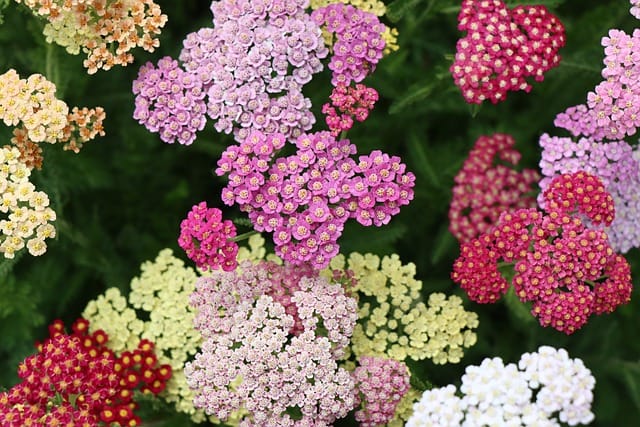How to grow Yarrows
The Yarrows flower, also known as Achillea, is a beautiful perennial plant that produces clusters of small, colorful flowers

In this article:
- Introduction to Yarrows
- Choosing the Right Variety
- Selecting an Ideal Location
- Soil Preparation
- Planting Yarrows
- Watering and Fertilizing
- Pruning and Deadheading
- Preventing Pests and Diseases
- Propagation Methods
- Overwintering Yarrows
- Common Companion Plants
- Creative Uses for Yarrows
- Frequently Asked Questions
- Conclusion and Final Tips
Introduction to Yarrows
The Yarrows flower, also known as Achillea, is a beautiful perennial plant that produces clusters of small, colorful flowers. They are hardy, low-maintenance plants that can add a splash of color and beauty to any garden or landscape.
Choosing the Right Variety
When selecting Yarrows, consider the variety that suits your specific needs. There are various types of Yarrows available in different colors, sizes, and growth habits. Some popular varieties include Achillea millefolium 'Paprika' with red flowers, Achillea 'Moonshine' with yellow flowers, and Achillea 'Coronation Gold' with golden flowers.
Selecting an Ideal Location
Yarrows thrive in full sun but can tolerate light shade. When choosing a location, ensure it receives at least six hours of direct sunlight per day. Additionally, Yarrows prefer well-drained soil, so select a spot that doesn't retain excessive moisture.
Soil Preparation
Prepare the soil before planting by removing any weeds or grass and loosening it with a garden fork. Yarrows prefer slightly alkaline soil with a pH between 6.0 and 7.5. If your soil is acidic, add some lime to raise the pH level.
Planting Yarrows
Yarrows can be planted either as seeds or nursery-bought plants. If planting seeds, sow them directly into the prepared soil in early spring. Ensure they are lightly covered with soil and water thoroughly. If using potted plants, dig a hole slightly larger than the root ball, place the plant in the hole, and cover it with soil. Water thoroughly after planting.
Watering and Fertilizing
After planting, water Yarrows regularly until they are established. Once established, they are drought-tolerant and require minimal watering. Water deeply but infrequently, allowing the soil to dry between watering sessions. Apply a balanced fertilizer in early spring to promote healthy growth.
Pruning and Deadheading
Yarrows benefit from regular deadheading, which involves removing faded flowers. Deadheading encourages continuous blooming and prevents self-seeding. Additionally, prune Yarrows in early spring to remove any dead or damaged stems, shaping the plant for optimal growth.
Preventing Pests and Diseases
Yarrows are generally resistant to pests and diseases. However, they can occasionally be affected by aphids, spider mites, or powdery mildew. Monitor your plants regularly and take appropriate measures if any issues arise. Insecticidal soap or horticultural oil can be applied to control pests, while proper spacing and good air circulation help prevent powdery mildew.
Propagation Methods
Yarrows can be propagated through division or stem cuttings. Division involves separating established clumps and replanting them, while stem cuttings involve taking 4-6 inch cuttings from healthy plants and rooting them in a well-draining medium. Both methods should be done in early spring or fall for the best chances of success.
Overwintering Yarrows
Yarrows are hardy perennials and can survive cold winters. However, mulching around the base of the plants with straw or leaves can provide extra protection. Cutting back the foliage to a few inches above ground level in late fall or early spring also helps maintain a neat appearance and encourages new growth.
Common Companion Plants
Yarrows are versatile plants that can be combined with various companion plants to create stunning combinations. Some popular options include lavender, salvia, coneflowers, sedums, and ornamental grasses. These combinations provide a beautiful and balanced display of colors, textures, and heights.
Creative Uses for Yarrows
Yarrows have several creative uses both in the garden and beyond. Apart from being a charming addition to flower beds, Yarrows can be used in dried flower arrangements, herbal teas, and natural dyes. Their fern-like foliage also adds texture and interest to bouquets and floral designs.
Frequently Asked Questions
Here are some frequently asked questions about growing Yarrows:
- Q: Can Yarrows grow in containers? A: Yes, Yarrows can be grown in containers as long as they have enough space, sunlight, and well-draining soil.
- Q: How often should Yarrows be fertilized? A: Yarrows benefit from a light application of balanced fertilizer once a year in early spring.
- Q: When is the best time to divide Yarrows? A: Early spring or fall is the ideal time to divide Yarrows.
Conclusion and Final Tips
Yarrows are a wonderful addition to any garden, providing beautiful blooms, low maintenance requirements, and versatility. By selecting the right variety, preparing the soil, and following proper planting and care techniques, you can enjoy the beauty of Yarrows in your garden for years to come.
